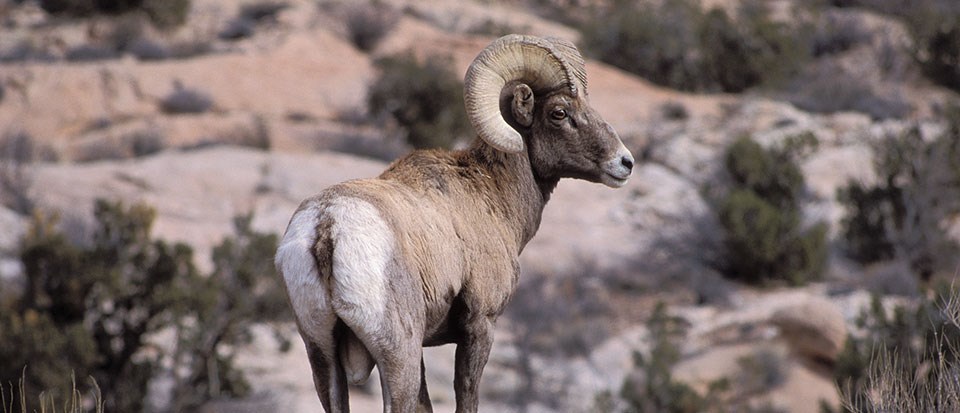
NPS/Neal Herbert Desert bighorn sheep are some of the most intriguing mammals of canyon country. They are wary of human contact, and blend so well into the terrain they inhabit, that sightings are a special event. Once feared of becoming extinct, the desert bighorn are making a tentative comeback in southeast Utah due to a comprehensive reintroduction effort by the National Park Service. Desert or Nelson’s bighorn sheep (Ovis canadensis nelsoni) are considered by most biologists to be a unique subspecies. Desert bighorns have adapted to hot, dry climates, unlike their Rocky Mountain cousins, and have longer legs, lighter coats and smaller bodies. Bighorn sheep are common in ancestral Puebloan and Fremont-era pictographs, an indication of their presence and prominence in indigenous cultures. Explorers in the late 1600s estimated that more than two million desert bighorn once roamed the southwest. By the late 1800s however, bighorn sheep had disappeared or declined in many areas. Extremely vulnerable to diseases from livestock, herd after herd of wild sheep were decimated by pathogens like scabies (an ear mite) and anthrax (a bacterial disease) introduced by domestic sheep. Bighorns were also killed by early explorers, settlers and trophy hunters. Increased competition with domesticated cattle and sheep for food didn’t help the situation. In 1975, Utah’s population numbered around 1,000 sheep. In the early 1980s, biologists began relocating bighorns from a native population in Canyonlands National Park in order to establish new herds. Since sheep are poor dispersers, this is the only way to return them to their historic ranges. To accomplish this, sheep are captured in nets fired from helicopters, their health and age assessed, and suitable animals are transported by ground to a relocation area. Since the program began, sheep have been reestablished in Arches National Park, Capitol Reef National Park and Glen Canyon National Recreation Area. Sheep relocated to the San Rafael Swell west of Arches have created two herds totaling more than 600 animals. Today, the bighorn population in Utah is estimated at 3,000 animals. There are roughly 75 sheep in Arches, and animals are often sighted along US 191 south of the visitor center. Human activity and development continue to threaten the desert bighorn sheep. The mortality rate of first-year lambs at Arches has been alarming in recent years. Though no specific cause has been identified, this trend may be due to increased vehicle traffic along highways coming into Moab. For the remaining herds to survive, intensive management and conservation measures may be necessary. The protection of undeveloped land and wilderness areas is critical to the species’ survival, and Arches will continue to play a large role in this effort. |
Last updated: April 8, 2022
